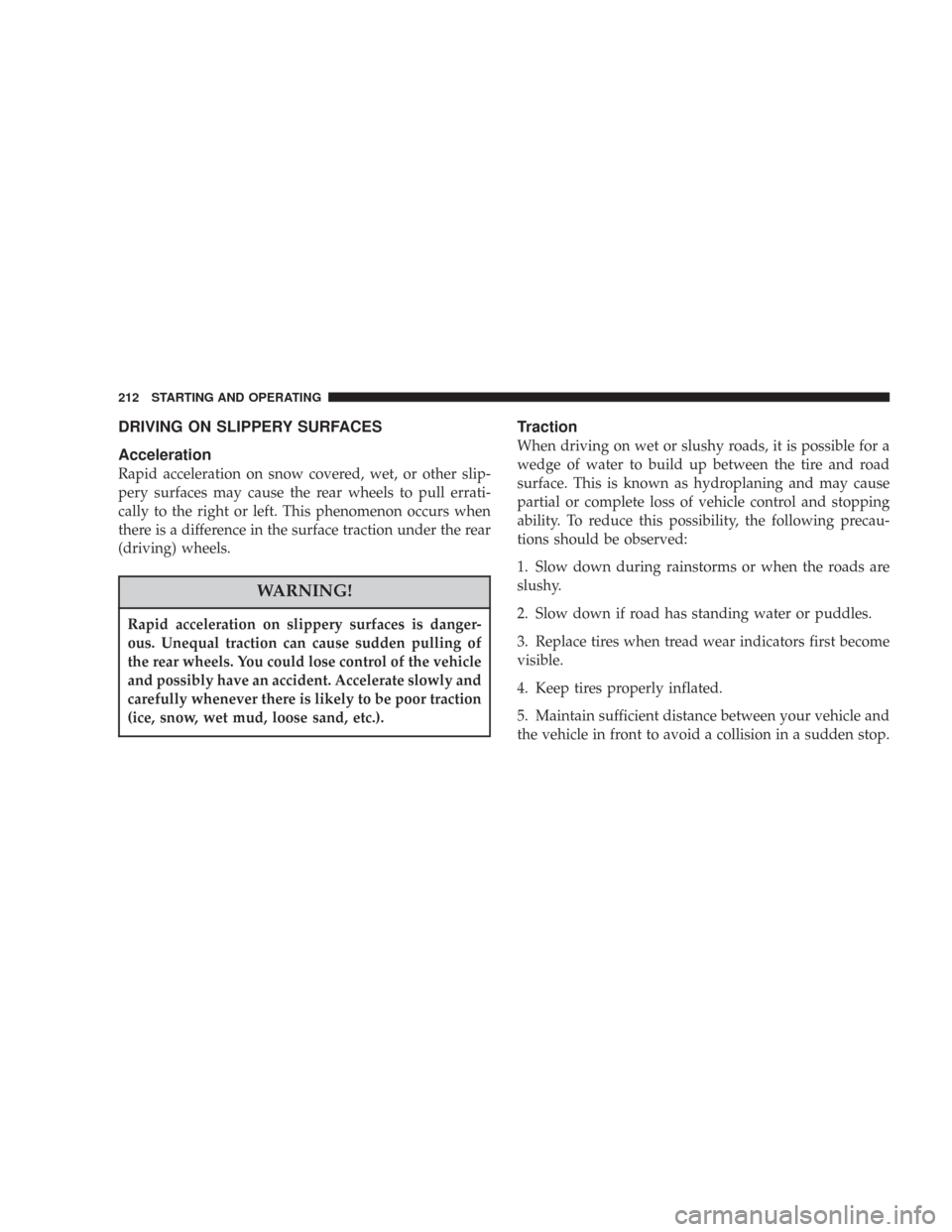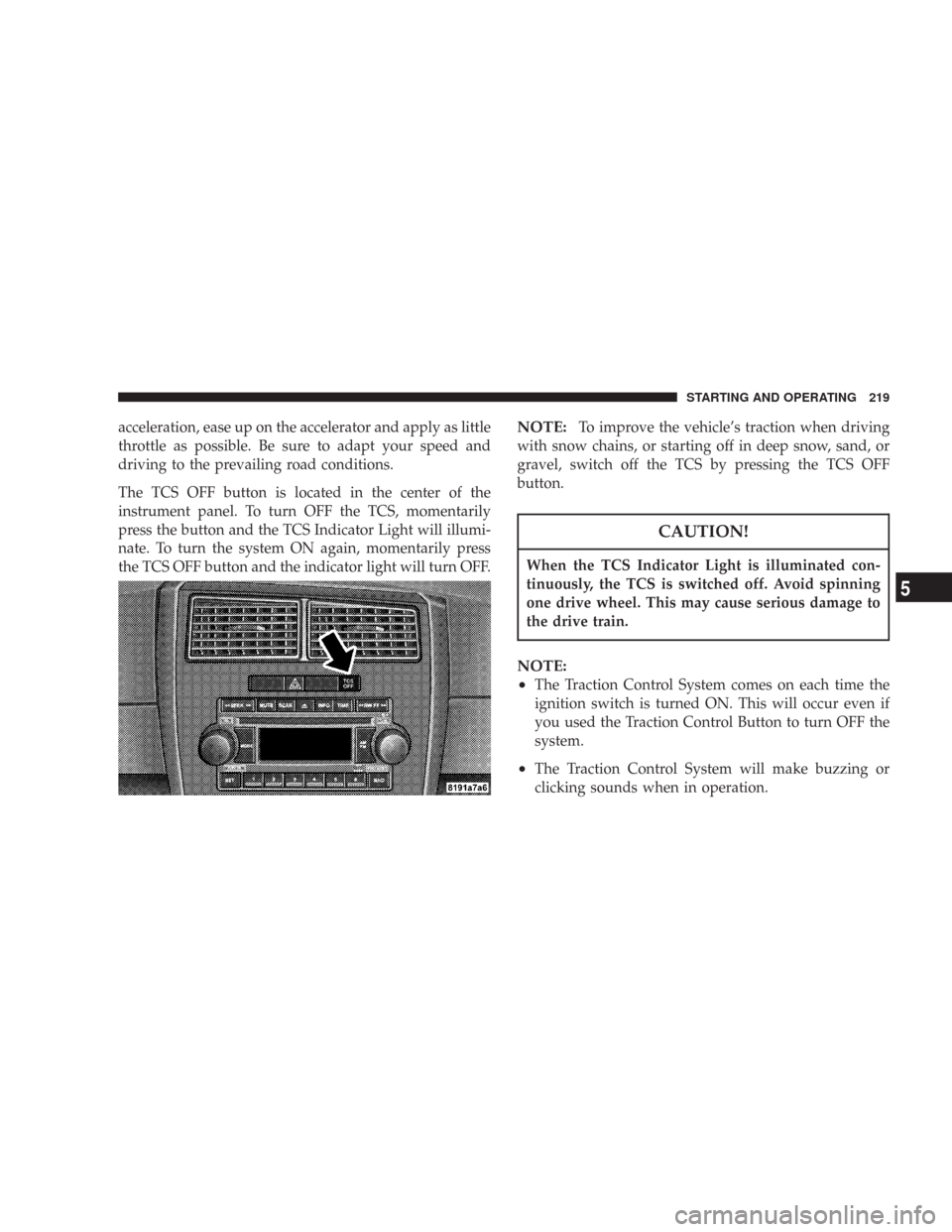Page 51 of 384

•Brake status (service and parking brakes)
•Accelerator status (including vehicle speed)
•Engine control status (including engine speed)
•Cruise control status (if applicable)
•Traction/stability control status (if applicable)
Child Restraint
Everyone in your vehicle needs to be buckled up all the
time — babies and children, too. Every state in the United
States and all Canadian provinces require that small
children ride in proper restraint systems. This is the law,
and you can be prosecuted for ignoring it.
Children 12 years and under should ride properly buck-
led up in a rear seat, if available. According to crash
statistics, children are safer when properly restrained in
the rear seats rather than in the front.
WARNING!
In a collision, an unrestrained child, even a tiny
baby, can become a missile inside the vehicle. The
force required to hold even an infant on your lap
could become so great that you could not hold the
child, no matter how strong you are. The child and
others could be badly injured. Any child riding in
your vehicle should be in a proper restraint for the
child’s size.
There are different sizes and types of restraints for
children from newborn size to the child almost large
enough for an adult safety belt. Always check the child
seat Owner’s Manual to ensure you have the correct seat
for your child. Use the restraint that is correct for your
child:
THINGS TO KNOW BEFORE STARTING YOUR VEHICLE 51
2
Page 126 of 384
INSTRUMENT PANEL AND CONTROLS
1 — Air Outlet 6 — Radio 11 — Ignition Switch
2 — Instrument Cluster 7 — Climate Control 12 — Hood Release
3 — Hazard Switch 8 — Heated Seat Switch* 13 — Trunk Release Switch
4 — Electronic Stability Program Off Button* /
Traction Control System Off Button*9 — Power Outlet 14 — Headlight Switch
5 — Glove Box 10 — Ash Tray* * If Equipped 126 UNDERSTANDING YOUR INSTRUMENT PANEL
Page 132 of 384

12. Electronic Stability Program (ESP)/Traction
Control System (TCS) Indicator Light — If Equipped
If this indicator light flashes during accelera-
tion, ease up on the accelerator and apply as
little throttle as possible. Adapt your speed
and driving to the prevailing road condi-
tions, and do not switch off the ESP or TCS — if
equipped. (See page 218 for more information.) (See
page 221 for more information.)
13. Electronic Stability Program (ESP) / Brake
Assist System (BAS) Malfunction Indicator Light —
If Equipped
The yellow ESP/BAS malfunction indicator
light will turn on when the key in the
ignition switch is turned to the “ON” posi-
tion. The light should go out with the engine
running. The system will turn this light on continu-
ously while the engine running if it detects a malfunc-
tion in either the ESP or the BAS or both. (See page 221
for more information.)14. Oil Pressure Warning Light
This light shows low engine oil pressure. The
light should turn on momentarily when the
engine is started. If the light turns on while driving,
stop the vehicle, and shut off the engine as soon as
possible. A single chime will sound when this light
turns on.
Do not operate the vehicle until the cause is corrected.
This light does not show how much oil is in the engine.
The engine oil level must be checked using the procedure
shown in section 7. (See page 295 for more information.)
15. High Beam Light
This light will turn on when the high beam
headlights are ON. Push the Multi-Function
lever away from the steering wheel to switch the
headlights to high beam. (See page 98 for more
information.)
132 UNDERSTANDING YOUR INSTRUMENT PANEL
Page 192 of 384

▫Anti-Lock Brake System — If Equipped.....214
�Power Steering........................217
�Multi Displacement System (MDS) -
5.7L Engine Only
......................218
�Traction Control System (TCS) — If Equipped....218
�Brake Assist System (BAS) — If Equipped....220
�Electronic Stability Program (ESP) —
If Equipped
..........................221
▫Synchronizing ESP....................223
▫ESP/BAS Malfunction Indicator And ESP/TCS
Indicator Lights......................223
�Tire Safety Information..................224
▫Tire Markings........................224
▫Tire Identification Number (TIN)..........227
▫Tire Loading And Tire Pressure...........228
�Tires — General Information..............232
▫Tire Pressure.........................232▫Tire Inflation Pressures.................233
▫Radial-Ply Tires......................235
▫Compact Spare Tire — If Equipped.........235
▫Limited Use Spare — If Equipped.........236
▫Tire Spinning........................236
▫Tread Wear Indicators..................237
▫Life Of Tire.........................238
▫Replacement Tires.....................238
▫Alignment And Balance.................239
�Self–Sealing Tires — If Equipped..........240
�Tire Chains...........................240
�Snow Tires...........................241
�Tire Rotation Recommendations...........241
�Tire Pressure Monitor System (TPMS) —
If Equipped
..........................242
▫Base System — If Equipped..............245
192 STARTING AND OPERATING
Page 211 of 384

•You can start out in first or second gear. The system
will ignore attempts to upshift at too low of a vehicle
speed.
•The transmission will automatically downshift to first
gear when coming to a stop.
•Starting out in second gear is helpful in snowy or icy
conditions.
•Avoid using speed control when Autostick�is en-
gaged.
•The transmission will automatically shift up when
maximum engine speed is reached while Autostick�is
engaged.
•Transmission shifting will be more noticeable when
Autostick�is engaged.
ALL WHEEL DRIVE — IF EQUIPPED
This feature provides full time All Wheel Drive (AWD)
with Anti-lock Brake System (ABS)/Traction Control.
The front wheels provide 38% of the torque, and the rear
wheels provide 62% of the torque. The system is auto-
matic with no driver inputs or additional driving skills
required.
CAUTION!
All wheels must have the same size and type tires.
Unequal tire sizes must not be used. Unequal tire
size may cause failure of the front differential and/or
the transfer case.
STARTING AND OPERATING 211
5
Page 212 of 384

DRIVING ON SLIPPERY SURFACES
Acceleration
Rapid acceleration on snow covered, wet, or other slip-
pery surfaces may cause the rear wheels to pull errati-
cally to the right or left. This phenomenon occurs when
there is a difference in the surface traction under the rear
(driving) wheels.
WARNING!
Rapid acceleration on slippery surfaces is danger-
ous. Unequal traction can cause sudden pulling of
the rear wheels. You could lose control of the vehicle
and possibly have an accident. Accelerate slowly and
carefully whenever there is likely to be poor traction
(ice, snow, wet mud, loose sand, etc.).
Traction
When driving on wet or slushy roads, it is possible for a
wedge of water to build up between the tire and road
surface. This is known as hydroplaning and may cause
partial or complete loss of vehicle control and stopping
ability. To reduce this possibility, the following precau-
tions should be observed:
1. Slow down during rainstorms or when the roads are
slushy.
2. Slow down if road has standing water or puddles.
3. Replace tires when tread wear indicators first become
visible.
4. Keep tires properly inflated.
5. Maintain sufficient distance between your vehicle and
the vehicle in front to avoid a collision in a sudden stop.
212 STARTING AND OPERATING
Page 218 of 384

MULTI DISPLACEMENT SYSTEM (MDS) - 5.7L
Engine Only
This feature offers improved fuel economy by shutting
off four of the engine’s eight cylinders during light load
and cruise conditions. The system is automatic with no
driver inputs or additional driving skills required.
NOTE:The MDS system may take some time to return
to full functionality after a battery disconnect.
TRACTION CONTROL SYSTEM (TCS) — IF
EQUIPPED
WARNING!
The Traction Control System (TCS) cannot prevent
the natural laws of physics from acting on the
vehicle, nor can it increase the traction afforded. The
TCS cannot prevent accidents, including those re-
sulting from excessive speed in turns, or hydroplan-
ing. Only a safe, attentive, and skillful driver can
prevent accidents. The capabilities of a TCS-
equipped vehicle must never be exploited in a reck-
less or dangerous manner, which could jeopardize
the user’s safety or the safety of others.
The Traction Control System (TCS) Indicator
Light, located in the instrument cluster, starts
to flash as soon as the tires lose traction and the
wheels begin to spin. This indicates that the
TCS is active. If the indicator light begins to flash during
218 STARTING AND OPERATING
Page 219 of 384

acceleration, ease up on the accelerator and apply as little
throttle as possible. Be sure to adapt your speed and
driving to the prevailing road conditions.
The TCS OFF button is located in the center of the
instrument panel. To turn OFF the TCS, momentarily
press the button and the TCS Indicator Light will illumi-
nate. To turn the system ON again, momentarily press
the TCS OFF button and the indicator light will turn OFF.NOTE:To improve the vehicle’s traction when driving
with snow chains, or starting off in deep snow, sand, or
gravel, switch off the TCS by pressing the TCS OFF
button.
CAUTION!
When the TCS Indicator Light is illuminated con-
tinuously, the TCS is switched off. Avoid spinning
one drive wheel. This may cause serious damage to
the drive train.
NOTE:
•
The Traction Control System comes on each time the
ignition switch is turned ON. This will occur even if
you used the Traction Control Button to turn OFF the
system.
•The Traction Control System will make buzzing or
clicking sounds when in operation.
STARTING AND OPERATING 219
5